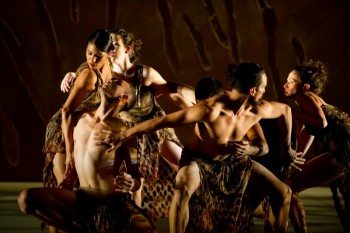The wonder of Kati Thanda: Bangarra’s Terrain

After the success of her award-winning Artefact in 2010, Bangarra artist in residence Frances Rings was commissioned by Stephen Page to create her first full-length work. The result is Terrain, a beautiful work inspired by the natural wonder of Kati Thanda (Lake Eyre).
Terrain, described as a hymn to country, explores the relationship of Indigenous people to country. In developing the piece “Rings”, composer david Page and designer Jacob Nash travelled to Lake Eyre, home for thousands of years to the Arabunna people. The stories and impressions they gained have been distilled into a piece that is just over an hour long. A number of scenes flow into each other, describing the everlasting changing cycle of the lake landscape, while incorporating references to contemporary concerns such as the struggle for land rights and the devastating impact of humans on the delicate balance of nature.
For Terrain, “Rings” has developed a distinctive choreographic language of ever unfolding movements, with tangled bodies evocative of gnarled trees, dancers climbing on top of each other, and a magical flowing weightlessness in the episode called “Landform”. The femininity of her choreography is most powerful during “Spinifex”, when the womens ensemble dance as spirit women low to the ground, drawing figures in the air with their fecund round bottoms.
The voice of Arabunna elder Reg Dodds (talking in language), who shared his knowledge and stories of the area with the creative team, is present in the sound track. Other sounds of country and city, collected by Page, are woven into his mostly lyrical score. For the design, Nash starts with a stark white blank canvass – a never ending salt plane – the only scenery is the bodies of the dancers. A series of spectacular backdrops are the sole colour for much of the piece, but the monotony of the blank floor is relieved in the nick of time with glorious swirls of gold light (by Karen Norris) in “Landform”. From then on, the colour builds, representing the life that flows into the lake with the coming of water. The final scene, “Deluge”, has more welcome colour with costumes (brilliantly realised by Jennifer Irwin) of soft blues and greens. I wanted this scene to last longer, but I guess that’s the lake for you – here today, gone tomorrow on its eternal cycle of drought and regeneration.
For all of its beauty, Terrain lacks dynamic variety and I found my attention wandering at times. However this was the premiere performance, and perhaps as the ensemble gain more familiarity with the chorography this may not present as a flaw. Also, without being able to refer to the descriptive program notes, I was unable to grasp the specific context of episodes, the understanding of which seemed necessary considering the degree of literal imagery present on stage.
Terrain continues its national tour to Sydney, Wollongong, Adelaide and Brisbane till October.

